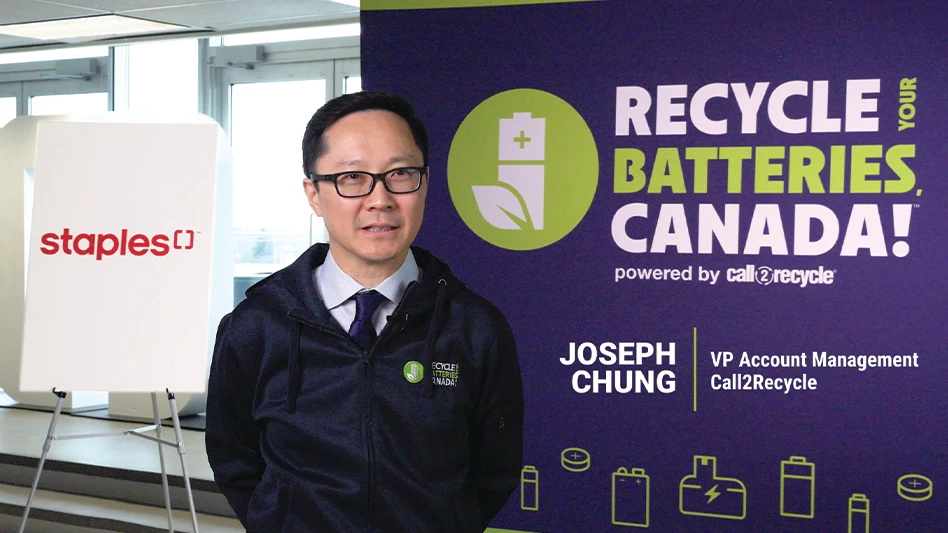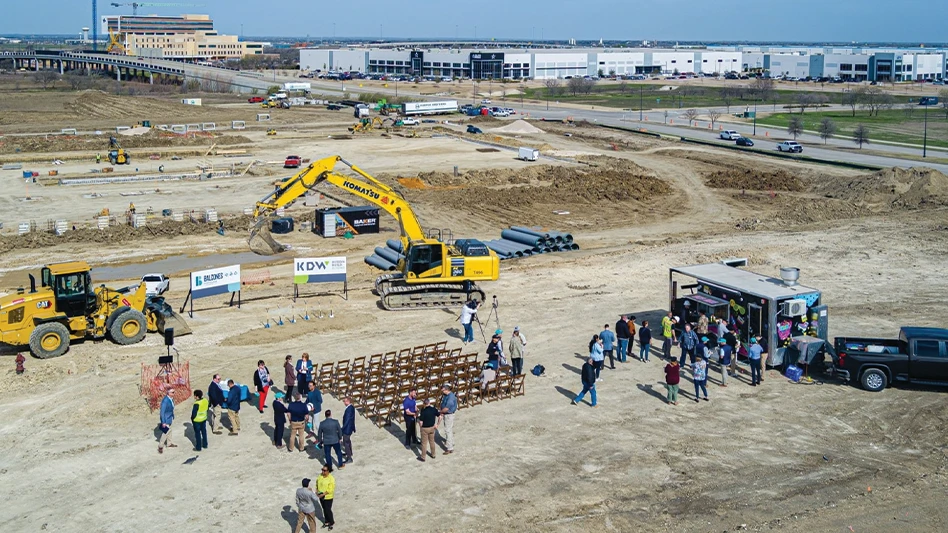
Photo by Chris Voloschuk
In Alexandra Pantzlaff’s experience, there are two major considerations that come to mind when maintaining an aging material recovery facility (MRF): maintenance and planning.
As the recycling superintendent for Outagamie County Recycling & Solid Waste in northeastern Wisconsin, she oversees one of the largest publicly owned MRFs in the country, a 24-tons-per-hour facility located in Appleton that was retrofitted in 2008. A focus on preventive maintenance and strategic equipment upgrades have kept the facility running smoothly as it serves about 16 percent of the state’s population and receives approximately 80,000 tons of residential, commercial and industrial material annually.
RELATED: MRF Operations Forum 2024: Managing the tipping floor
“[The county mission statement is] everything that we do, whether it be the planning, the maintenance, the long-term planning we do to provide our county, our communities these services, we do in an environmentally sound and economical way,” Pantzlaff said during a presentation at the MRF Operations Forum, hosted by Recycling Today Events in October in Chicago.
The session, Case Studies: Maximizing Older Plants, provided several examples of how aging MRFs have adjusted to changes in technology, tons and the labor market.
The right time for a change
As part of a county agency that needs to get approval from various boards and committees before implementing a project, Pantzlaff said planning for the MRF is done roughly five to seven years in advance, meaning any upgrades need to be carefully considered and are paid for through her organization’s revenues, which can come from tipping fees, commodity sales or grant funds, for example.
The facility has completed several upgrades in recent years and has retained a consultant to help with long-term planning in order to keep the facility running for as long as possible.
“We’re looking at various kinds of things like the recycling trends in the markets,” Pantzlaff said. “We’re looking at what’s in the stream and what we are going to be asked to handle, how are we going to handle it and what kind of equipment are we going to need. How do we install it? When do we install it?
“We’re also looking at the life of our equipment as a whole. Again, at what point does it become obsolete, and how long can maintenance keep it alive before it does need to be replaced?”
She noted that future population growth, which could affect inbound tonnage and material in the stream, also are being considered.
Since 2009, the Appleton MRF has utilized a Bulk Handling Systems (BHS) single-stream system capable of processing 25 tons per hour. Within the last year, for example, the facility has added four robotic sorters with artificial intelligence (AI) capability to its container line and have improved its sortation of plastics and aluminum.
“They were really a great addition to our system,” Pantzlaff said. “They’ve done proof of concept, and everybody’s really happy with this.”
Ernesto Valencia, plant manager at Chicago-based Homewood Disposal Services, said his company, a single-MRF network that was built in 2009, approaches potential upgrades by answering two questions: Does it increase commodity revenue per ton, and does it reduce processing cost per ton?
“When we’re upgrading, we always have challenges,” Valencia said of his facility, which processes between 350 and 500 tons per week. “We have capital costs; that’s the most important one. You have technology that’s always changing and upgrading, and, for us, we have inbound materials that can change. And, as a single-plant network, it’s very difficult for us to divert any type of material.”
He said the facility’s tip floor can hold about 1,200 tons and has several bays across its yard that can hold 100 to 200 tons if needed. “If we were to take downtime for an upgrade, we’d probably have about a week max,” he added. “In that week, it’s up to our OEM [original equipment manufacturer] to find out how they can give us our upgrades for the facility in that time period. We have limited options to divert our material, so we have to work very quickly and get our upgrades done in a very fast pace.”
In 2017, Homewood added four nonwrapping screens that cut down on employee-led daily maintenance and improved safety. In 2019, it upgraded its old corrugated container (OCC) screen and quickly increased its recovery rate of that commodity. In 2022, it upgraded its four optical sorters on the commingled side of its operation, and recently added two AI-powered robots to its mixed paper line to help with quality control.
As the Area Manager of Plant Operations for Republic Services Inc.’s Great Lakes region, Margot Swank oversees the Oberlin, Ohio, MRF—a top-performing facility in the region that was built in 2013. The 72,000-square-foot facility utilizes a 35-tons-per-hour single-stream system designed by the San Diego-based CP Group, and Republic has made a number of changes to the facility over time to meet the challenges of evolving tons and labor availability.
Strategic upgrades at the Oberlin facility include the replacement of screens, including a commercial OCC screen, in 2020; the addition of two MSS Fibermax optical sorters in 2021 and 2022; a metering bin replacement in 2023; and the addition of two EverestLabs robots on the MRF’s last-chance line that same year, among others.
“That’s not where the story ends for the Oberlin facility, and we’re already continuing to look ahead to 2026 and beyond in terms of what we want to do to keep this as one of our top-performing facilities, even as it continues to age,” Swank said.
Staying up and running
Limiting equipment downtime was a chief concern for each panelist. In the effort to keep aging equipment running as efficiently as possible, each MRF has taken a proactive approach to maintenance.
At the Oberlin MRF, Swank pointed to a maintenance “pit crew” comprised of the facility’s equipment operators and sorters who are trained to address issues together as they arise.
“You might immediately have four to five people who are on [a screen, for example] checking out different components, trying to find the source of that issue so that it can be resolved more quickly,” she said, adding that the facility has an industrial electrician on staff who has helped diagnose problems and kept equipment running with minimal downtime.
At Homewood, Valencia said accountability has been the guiding maintenance principle, noting that his mechanics are all responsible for specific pieces of equipment. Additionally, the plant’s equipment operators help with smaller maintenance tasks, freeing up the mechanics to focus on preventive work and the bigger pieces of machinery such as the facility’s balers and conveyors.
“By assigning everyone their own pieces of equipment, we have seen less downtime for maintenance on screens, opticals, etc.,” he said. “Chains used to wear pretty fast on the equipment, and they used to catch us during operational hours from time to time. Ever since we assigned everybody their own screens and their equipment we have not seen that much downtime in maintenance. All major pieces of equipment went from an average of 5 percent to 8 percent of downtime to 3 percent to 5 percent maintenance downtime. We’ve had two months this year with under 3 percent and one month with under 2 percent of maintenance downtime.”
Valencia said spot checks also are performed on machines to ensure preventive maintenance has been properly performed. Also, Homewood tries to keep multiples of different machine parts in stock at all times to prevent excess downtime.
Pantzlaff said the Outagamie MRF runs two operating shifts and a third for maintenance, but as the facility has aged, mechanical downtime increased. Staying within her agency’s budget, a third-party millwright service was brought in to staff the third shift and provide a wide variety of skills on an as-needed basis, saving on labor costs and freeing up in-house maintenance staff to address issues arising during operational hours. Pantzlaff said the third-party also has helped refurbish equipment to keep it running longer.
In an effort to save on equipment costs, Pantzlaff recommended looking for local parts manufacturers in addition to working with an OEM.
“Take a look around,” she said. “[Local companies] may be able to provide a cost savings or just be able to have a quick turnaround on pieces of equipment that you may need and can avoid that unplanned downtime. Then maintenance is all good and well.”
Investing in people
According to Valencia, Homewood looks for as many opportunities as possible to invest in and incentivize its employees, especially when it comes to those performing maintenance tasks.
He said there are monetary incentives provided, such as quarterly and yearly bonuses and awards based on attendance and safety, for example. The company also provides nonmonetary perks such as lunches, merchandise and development opportunities.
“We all know that the more you know and do, the more valuable you are,” he said. Therefore, every member of the team is taught every aspect of the equipment they operate, including maintenance, so they can build their careers and increase their value.
“If we have a mechanic that knows how to weld, we have him teach everybody else,” Valencia said. “Everybody learns the mechanical side. Everybody knows how to change a bearing and the easy things, but it’s the welding, the fabricating, how you can structure conveyor belts. Sometimes we don’t have the option of waiting for another third party company to come in and get you going. If you’re able to build your own team, that’s huge.”
Homewood team members also are sent to training schools to better learn the equipment, and the facility occasionally brings in its system OEM for inspections and to educate its mechanics.
Pointing out the common industry challenge of finding and keeping good employees, Swank said Republic considers retention an important operational investment, along with equipment. The multifaceted pit crew at the Oberlin MRF is one example of that commitment to people, she added.
“It’s hard to find people,” she said. “And when we find good employees, we want to invest in them. We want to keep them and make sure that they feel [connected] to their role and to the company.”
Latest from Recycling Today
- Recycled steel price crosses $500 per ton threshold
- Smithers report looks at PCR plastic’s near-term prospects
- Plastics association quantifies US-EU trade dispute impacts
- Nucor expects slimmer profits in early 2025
- CP Group announces new senior vice president
- APR publishes Design Guide in French
- AmSty recorded first sales of PolyRenew Styrene in 2024
- PRE says EU’s plastic recycling industry at a breaking point





